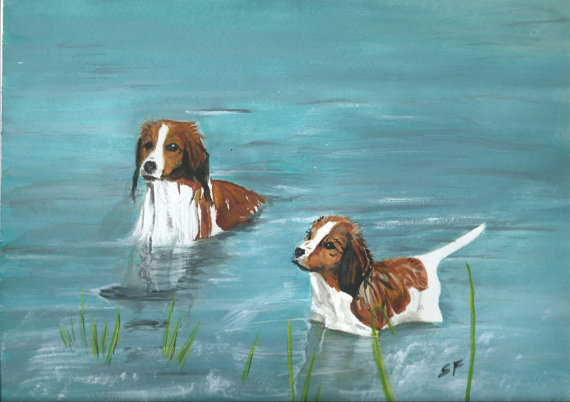
We always defer to breed experts, but as this story was shared with us by someone who knows the breed, we’re running with it.
On occasion, tri-colored Kooikerhondje puppies are born, but the color isn’t allowed in the breed standard. As the story goes, the Dutch decided to disqualify the color during the second World War to irritate the Germans by making the official color “orange and white,” orange being the national color of the Netherlands. As it was, breeding Dutch dogs was a silent “up yours” to the Germans for their occupation of the Netherlands, and that they were orange was particularly “sweet” since the name of the Dutch Royal House was Van Oranje.
Kooikerhondje in watercolor by Sheryl Fuller is available for purchase here.

I do not know where this story came from, but i don’t think this can be true! The ancesters of the Kooikerhondje were little spaniel-like dogs used as a decoy in enclosures where they lured ducks into a kind of trap, so that the ducks could be cought, to be eaten. As it was not really a “breed”, but only used for this purpose, type of coat and colour were not important. The only demand was that it had to be bright in colour, so mostly red with white marking. But black with white or tri-colour was also allowed. When around 1900 the form of duck hunting with the Kooikerhondje was no longer a profession, the little dogs were no longer needed and the “breed” was exctinct. It was “re-created” by Baroness van Hardenbroek- van Ammerstol. She wanted to restore the small, Spaniel-type of dog and used an image that was frequently painted by Dutch artists like Jan Steen, for example. In 1940 she send out a traveling salesman throug the country with a picture and a lock of hair to look out for the little type of dog she needed to start her breeding. Her first litter was born in 1942 with kennelname “van Walhalla”. Of course there were tri-colours and black-and-whites in the first litters as descendants were unknown. This was allowed in the beginning, because black pigmentation was needed as Kooikerhondjes must have black markings in their coat in the form of long, black hairs on the ears, called “ear-bells”. This is a very important breed characteristic. It takes many years to develop a breed and it was only in 1966 that the first Kooikerhondje was registered in the NHSB, called “Nico” in a special register. In 1971 The Dutch Kennelclub officialy recognized The Kooikerhondje as a Dutch breed. So allthough the early founding of the breed took place during WW II i don’t think disqualifying was an issue then. The picture i send with this comment is of a Kooikerhondje doiing his original job. There are still a number of duckcatchers in the Netherlands but nowadays only for educational purposes, so the ducks don’t get eaten. 🙂 Some of the catchers actually work with Kooikerhondjes.
It likely isn’t true, Elly, but like many “dog legends” or folklore tales, it pokes fun at history. We welcome your comment, nonetheless, because it’s a wonderful explanation of actual history of a wonderful breed. Yours is probably the first really good picture we’ve seen of a “eendenkooi” (do we have that right?) and we’re heartened to learn that the Dutch have keep on some duckcatchers for educational purposes. Thank you for writing, it is a fabulous comment!